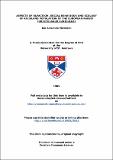Files in this item
Aspects of olfaction, social behaviour and ecology of an island population of the European rabbit (Oryctolagus cuniculus)
Item metadata
| dc.contributor.author | Sneddon, Ian Alexander | |
| dc.coverage.spatial | 430 | en_US |
| dc.date.accessioned | 2012-06-20T11:45:54Z | |
| dc.date.available | 2012-06-20T11:45:54Z | |
| dc.date.issued | 1985 | |
| dc.identifier | uk.bl.ethos.355539 | |
| dc.identifier.uri | https://hdl.handle.net/10023/2823 | |
| dc.description.abstract | Olfactory behaviour in the European rabbit (Oryctolagus cuniculus) has been studied extensively under laboratory and semi-natural conditions. Results of observations on aspects of the olfactory behaviour of a free-living population of rabbits are presented. To facilitate interpretation of these results, considerable preliminary information about the population was collected. The study was conducted over a three year period on the Isle of May off the east coast of Scotland. A total of 326 rabbits were trapped and marked to permit identification in the field, and data on sex, age and social status of these individuals was collated. Data on the overall structure and fluctuations in the population are presented. The social organisation and home ranges of rabbits at four study sites throughout the three years are described. Observations indicate that the social organisation of free-living populations is more complex and variable than previous descriptions of semi-natural populations would have led us to expect. The reproductive performance of the population was investigated and intra and interwarren variations are analysed with respect to warren and group size. Results indicate an inverse relationship between warren size and reproductive success. The most frequently observed group composition (2 males, 2 females) was also the most reproductively successful. Daily and seasonal activity patterns of different age, sex and social status classes of rabbits are described. Olfactory communication was investigated by analysis of the frequency, daily and seasonal variation, and behavioural context of odour related activities performed by members of different age, sex and social status classes. The importance of using appropriate methods for the sampling of behaviour in field studies of olfaction is stressed. The present study concentrates on behaviour related to latrines; chin marking of the substrate and of conspecifics; enurination and urine squirting; and pawscraping. The results suggest that different scent products may carry similar information but analysis of variations in the frequency and context of odour deposition suggests that the deposition of scent fulfills a variety of functions. | en_US |
| dc.language.iso | en | en_US |
| dc.publisher | University of St Andrews | |
| dc.rights | Creative Commons Attribution-NonCommercial-NoDerivs 3.0 Unported | |
| dc.rights.uri | http://creativecommons.org/licenses/by-nc-nd/3.0/ | |
| dc.subject.lcc | QL737.L32S6 | |
| dc.subject.lcsh | Rabbits | en_US |
| dc.subject.lcsh | Rabbits--Behavior | en_US |
| dc.subject.lcsh | Rabbits--Juvenile literature | en_US |
| dc.title | Aspects of olfaction, social behaviour and ecology of an island population of the European rabbit (Oryctolagus cuniculus) | en_US |
| dc.type | Thesis | en_US |
| dc.type.qualificationlevel | Doctoral | en_US |
| dc.type.qualificationname | PhD Doctor of Philosophy | en_US |
| dc.publisher.institution | The University of St Andrews | en_US |
This item appears in the following Collection(s)
Except where otherwise noted within the work, this item's licence for re-use is described as Creative Commons Attribution-NonCommercial-NoDerivs 3.0 Unported
Items in the St Andrews Research Repository are protected by copyright, with all rights reserved, unless otherwise indicated.


